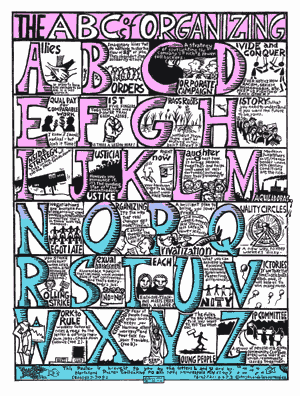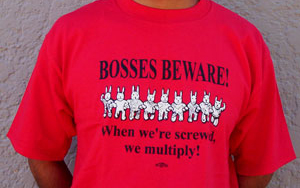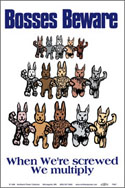These are some Northland stories that were posted on our old site. To add your own stories, memories or comments, please join in on our blog.
Approved by Management
Dear Northies,
A few years ago I got a bunch of militant union posters from you. I posted [them] on the union bulletin boards around the plant. I told you at the time I'd report back how it went. Although the posters were pretty militant, the Local President approved them. Management was quite upset and made the following contract clause one of their top bargaining issues later that year:
All such matters may be posted only upon the authority of
officially designated representatives of the Union and must be
approved by Management.
So for several years I had to get a foreman's initials on anything I posted. I am able to ignore that now, but only because I impose "self-censorship." Such is life under the dictatorship of the owners. Now I distribute this stuff at union meetings and in person.
We did do a successful campaign using buttons during negotiations a couple of months ago. We had been getting "lump sum" payments in place of some raises for many years and we decided we'd had enough. I had a local shop make up 250 buttons saying "DUMP THE LUMP" and our Rapid Response team saw to it that on the designated day 85% of the members wore the button. When management still refused, we took a vote and a big majority voted to strike. On the last day of negotiations management agreed to give across the board raises each year. The VP of Personnel said, "Now you can tell the people to throw away all those damn buttons!"
It's people like you that inspire us to use such tactics. Thank you for being there and doing what you do.
Doug Marshall
USW Local 8957
Happy Anniversary
Congratulations on your anniversary. May you celebrate many more. I have a little story about Northland Poster's place in my life.
Five years ago, when I was 52, I happened to be an apprentice at [an engineering union]. Heavy equipment operators. In the normal course of events, one gets a job as an operator and then gets signed up by the union. Two years earlier, I'd been given a job by a major excavating company. The job was given to me as a favor to my partner who worked for the company as a site supervisor. But I was a competent operator and a hard worker, so the main supe decided he keep me on and called the union BA to come sign me up. I was very excited. The BA came to the job site, saw that I was a woman, and refused to sign me up.
 I was hired back by the same company in the spring, and once again the union refused to sign me up, a
different BA this time. I finally made it into the union through the back door, the one reserved for women and
people of color, the apprenticeship program. It was not an easy apprenticeship, especially the classroom
portion. Oh, the work was doable, but the racism and sexism of the union officials and instructors (except one,
who really did try) was overt, constant, and appalling. Every day was a trial. Then one day I discovered your
ABCs of Organizing poster in a seldom used room. At every break I would stand in front of that poster, feeling
a sense of comradeship, taking in the energy of people who were making a difference for women and people of
color. My kin were there in that awful place, my kin were you and I felt you through your poster.
I was hired back by the same company in the spring, and once again the union refused to sign me up, a
different BA this time. I finally made it into the union through the back door, the one reserved for women and
people of color, the apprenticeship program. It was not an easy apprenticeship, especially the classroom
portion. Oh, the work was doable, but the racism and sexism of the union officials and instructors (except one,
who really did try) was overt, constant, and appalling. Every day was a trial. Then one day I discovered your
ABCs of Organizing poster in a seldom used room. At every break I would stand in front of that poster, feeling
a sense of comradeship, taking in the energy of people who were making a difference for women and people of
color. My kin were there in that awful place, my kin were you and I felt you through your poster.
That poster played a large role in my ability to continue returning to [the Local] day after day. Every morning, before I went to class, I'd stand in front of the poster and say, "Here I am, and I know you're out there. You remind me that the world is bigger than this union, and that makes me stronger. Thank you."
Thank you indeed. Happy anniversary.
Nancy Evechild
Bunnies on the move
Nothing had worked for the American Postal Workers in Danbury, Connecticut. Postal authorities continued to dismiss worker demands for contract compliance. The contract required that workers whose jobs were eliminated be offered new work within a fifty mile radius. Management claimed that this was not possible to do.
 "Bosses Beware: When We're Screwed We Multiply" read the backs of 300 bright red shirts with an image
of militant bunnies marching arm in arm. The local's logo was emblazoned on the front. Every worker at the
General Mail Facility arrived to work wearing the t-shirt on the day of the Post Master General's visit from
Washington D.C. Mortified, management began to pay attention.
"Bosses Beware: When We're Screwed We Multiply" read the backs of 300 bright red shirts with an image
of militant bunnies marching arm in arm. The local's logo was emblazoned on the front. Every worker at the
General Mail Facility arrived to work wearing the t-shirt on the day of the Post Master General's visit from
Washington D.C. Mortified, management began to pay attention.
The attention wasn't the welcomed kind. Fuming over their embarrassment, management sent a letter to all employees prohibiting the wearing of the shirts because they violated the Postal Service's "zero tolerance for violence" policy. The workers, amused but not deterred, knew they had disoriented the employer. They contacted the Northland Poster Collective-the group that had design the T-shirt-and ordered 300 more shirts but this time without the offending text. They also requested other bunny paraphernalia and threatened to picket national postal officials scheduled to come to town.
Fearing more embarrassment, management reached a settlement with the local, discovering that they could find local jobs for their workers after all. They also backed down on their T-shirt ban. The replacement shirts remained in their boxes.
Management had walked right into an untenable position in which they would look ridiculous whether they accepted the right of workers to wear the shirts or not. The workers were able to come up with creative ways to follow up that could keep the heat on indefinitely.
Bunnies 2
 Bosses at the Minneapolis Star Tribune also faced the power of workers with bunnies tees from Teamster
drivers on the loading dock when shop steward Rick Sather began to distribute them to drivers. Workers began
to wear them some days and other days wear plain red t-shirts under their jackets. Supervisors got sore
necks trying to figure out if the shirts had bunnies or not. When they tried to discipline one worker for wearing the shirt, others
decided that that was unfair and started sporting them as well. Sather was told that the wording was
threatening, but the supervisor was not satisfied when he covered the letters with masking tape. In the end,
management agreed to drop disciplinary charges against one worker (in a case�unrelated to the bunnies�that
could have led to his dismissal) if only the workers would stop wearing those pesky wabbits!
Bosses at the Minneapolis Star Tribune also faced the power of workers with bunnies tees from Teamster
drivers on the loading dock when shop steward Rick Sather began to distribute them to drivers. Workers began
to wear them some days and other days wear plain red t-shirts under their jackets. Supervisors got sore
necks trying to figure out if the shirts had bunnies or not. When they tried to discipline one worker for wearing the shirt, others
decided that that was unfair and started sporting them as well. Sather was told that the wording was
threatening, but the supervisor was not satisfied when he covered the letters with masking tape. In the end,
management agreed to drop disciplinary charges against one worker (in a case�unrelated to the bunnies�that
could have led to his dismissal) if only the workers would stop wearing those pesky wabbits!
Cartoon Story
Rainbow Foods in the summer of 1999 had gone too far this time and Minnesota workers weren't going to take it lying down. Management installed a new "anti-shrinkage" policy and set up a toll free anonymous hotline where employees could rat each other out for shoplifting. If management busted a person called in by a worker, the worker was given a substantial cash reward. Lunch bag searches and other intrusive policies were instituted. Morale among the Rainbow Food workers was at an all time low. Management ignored the union's requests to meet, and refused to even return phone calls.
Although Minneapolis' local took a traditional route and filed charges against the company, St. Paul United Food and Commercial Workers Local 789 picked a more creative first strike. They enlisted Ricardo Levins Morales to design a series of cartoons expressing their frustration with the company.
A brainstorming session between the artist, Rainbow workers, and union staff resulted in cartoons that irreverently lampooned company policy, renaming the company: "Blameyou Foods," and illustrating the workers' complaints. With representatives from every store at their general membership meeting on Tuesday, Local 789 decided to distribute the cartoons among workers at 8 am in all eleven stores the next morning.
After the first cartoon was unleashed on the shop floors (and under supervisors, doors), management left a message on Local 789's answering machine by 8:30 am asking to meet with union President Bill Pearson on Thursday. Workers had started to make badges out of the cartoon for their uniforms and were passing on the cartoon to truck drivers who carried it to other parts of the country.
The unusual tactic brought about an unprecedented and speedy response from the company. Rainbow Foods agreed to hold five informal meetings with workers representing different stores, and to listen to their complaints. These meetings gave workers a real voice and brought about noticeable changes rapidly, including improved lighting in the parking lot. New cartoons featured thermometers that rose and fell according to the workers happiness or dissatisfaction with Rainbow Foods' behavior.
Local 789 caught Rainbow Foods off guard with a creative response that still played by the rules. A well coordinated action and the accompanying surge in worker morale convinced management that a more humble approach to worker relations might be the wiser course.